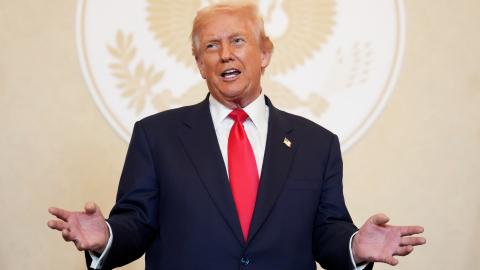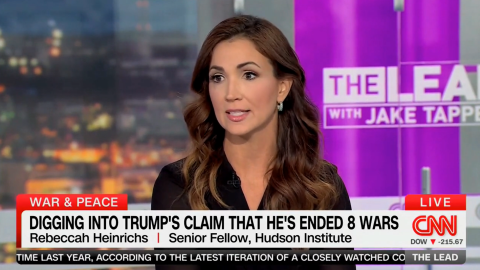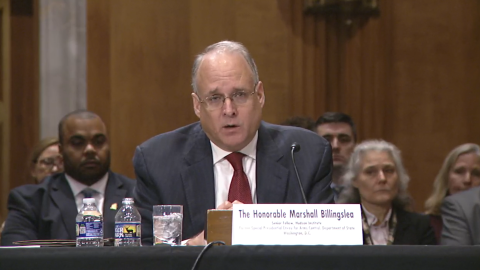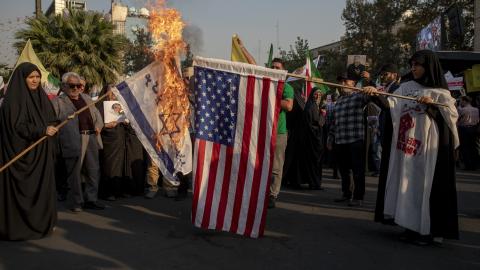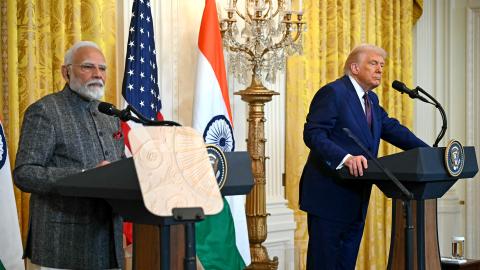The Trump Administration’s new 50 percent tariff on India, together with public barbs at India’s “dead” economy and “obnoxious” trade barriers, have pushed US-India relations off a cliff in recent weeks—threatening decades of progress in strategic cooperation between the world’s two largest democracies.
Although these dramatic trade developments have eclipsed all else, they follow what had already been the lowest point in US-India ties in the last quarter-century. To recap: since April, when an allegedly Pakistani-backed terrorist attack killed 26 Indian civilians in Kashmir, the cascade of actions taken by the Trump administration appeared designed to offend India’s leadership.
President Trump’s claims about America’s approach to halting India-Pakistan hostilities, condemnation of Apple’s investment ambitions in India, and embrace of Pakistan’s military leadership all deeply antagonized New Delhi. In response, Indian officials publicly contradicted President Trump’s statements and began recalibrating their ties with China. Only then did the trade rupture occur, putting the downward spiral into overdrive.
True, it can be difficult to separate theater from substance in many of these developments, given that the evidently fractious trade negotiations have been driven by an administration that is unorthodox in methods and not known for diplomatic subtlety. But whatever the motivations, there can be little doubt at this point that the implications for US-India relations could be enduring—and disastrous for American interests.
Rejigging trade and curbing India’s purchase of Russian oil are reasonable goals for the administration to pursue, but not at the cost of 25 years of progress with New Delhi in the world’s most strategically vital region. Fumbling India’s rise would constitute a generational strategic failure, comparable to—and compounding—America’s misjudgments about China’s rise at the turn of the century.
Thucydides’ Trap, Kautilya’s Solution
The best way to grasp India’s strategic significance today is through the lens of Harvard professor Graham Allison’s famous “Thucydides Trap.” Inspired by the fifth-century BC Greek historian Thucydides, Professor Allison proposes that whenever a rising power threatens to displace an established great power, the risk of war between the two tends to escalate. Between the overconfidence that accompanies economic ascent and the insecurity of the incumbent, Allison argues that in most cases, zero-sum dynamics push both powers toward collision.
It is hard to overstate the gravity of that challenge in a world in which a resurgent China’s rapidly expanding nuclear arsenal is commanded by a dictator with Mao-like authority and global ambitions. But in the face of the defining geopolitical threat of a generation, Allison’s recommendation is tepid: creative diplomacy between the United States and China is the best, if uncertain, hope to avert a conflict of unimaginable proportions.
Kautilya, often referred to as “India’s Machiavelli,” provides a better solution in his Arthashastra, classical India’s canonical work on statecraft that was consolidated in its current form roughly two millennia ago, though its roots go back centuries earlier. Like Thucydides, Kautilya sees two growing powers of similar strength as “innate” enemies that will tend towards conflict. But rather than focusing on how the two powers might work together to overcome the systemic forces pushing them towards hostilities, Kautilya rather suggests that managing the distribution of power around those states is more consequential. An ancient rendition of the “enemy-of-my-enemy” principle, Kautilya advises states to empower other parties whose interests naturally conflict with their adversary’s, tilting the broader strategic landscape in their favor.
India and the United States may have differences in trade, diplomacy, and religious liberty, but these pale in comparison with the structural friction both have with China. And while the United States’ rivalry with China may be on a much grander, global scale compared to India’s, India’s pressure points with the People’s Republic are even more critical to its national self-interest. The neighboring civilization-states have already fought a major war and periodically face off along their uneasy borders, which initiated a deadly clash in 2020. China continues to bolster its ability to assert control over numerous contested territories controlled by India, including Arunachal Pradesh (an entire state the size of Austria). According to the Indian military, China also provided active intelligence support to India’s archenemy, Pakistan, during the bitter aerial strike campaign in May.
For the United States, the timing of India’s rise is nothing short of providential as Washington faces an adversary of greater economic and military muscle, in both absolute and relative terms, than it has ever had to contend with. Although India’s GDP is currently only about a fifth of China’s, the South Asian behemoth just edged out China as the world’s fastest-growing major economy and the world’s most populous nation, differentials that are projected to hold and increase, respectively, for the foreseeable future.
These trends indicate the beginning of the greatest shift in the world’s balance of power since China’s rise, albeit at a comparatively slower rate. Misjudging how to approach that last seismic shift of this magnitude created the defining challenges that the US faces today. Getting India wrong now would be similarly disastrous.
A rising India is the only viable opportunity that the United States has not just to manage Thucydides’ Trap, but to transcend it. This won’t require making India a traditional American ally, despite the instincts of many decisionmakers. India’s colonial experience has bred a deep skepticism of binding alliances with great powers, and its civilizational pride and multipolar ambitions make it allergic to even the appearance of formal alignment.
Rather, the United States needs only to help make India stronger as its interests continue to clash far more with China’s than with America’s. In so doing, the United States can disrupt the inherently unstable bipolar dynamics that are pushing the world toward catastrophic great power conflict and impose massive complications on Beijing’s grand ambitions in the process.
An American-supported ascendant India will not be a fix-all. Still, it would dramatically constrain Beijing’s options and help to blunt some of the worst bipolar dynamics exacerbating Sino-American animus. And to the extent that Washington is able to accelerate India’s rise, it can both shorten the window of Thucydidean instability that threatens global peace and prosperity and enhance the likelihood that a US-boosted India has still more mutual interests with the United States than it does with China. In this light, formal alliances may be useful and better trading arrangements worthwhile, but a rising, closer India would be nothing short of transformative for America’s strategic position.
US-India Relations: Misguided Misgivings
The Trump administration’s more aggressive posture towards New Delhi follows growing misgivings among many India watchers in recent years that have clouded analysis about strengthening US-India ties. One of the chief reasons for this growing hesitancy is a dawning comprehension that despite India’s large and surging economy, it has its own share of problems. Optimistic—but still realistic—projections of India’s growth fail to match bearish estimations of China’s projected GDP anytime soon, leading some to wonder just how useful India’s rise will really be for the United States.
But these concerns are misguided. India need not match China’s heft to pose a critical challenge to its ambitions. It would not be the first time that a formidable, but lesser, power confounded the ambitions of a global colossus: from the ancient Greeks’ permanent halting of the Persian Empire’s westward expansion, to Vietnam’s persistent, bruising impacts on America’s Cold War options, strategically-positioned forces with enough heft in their own region to challenge larger superpowers can change the course of history.
China already considers Japan, with a small military and aging population, a considerable obstacle to its strategic outlook. How much more constraining will India be, which will soon make up a considerably greater proportion of China’s economy than Japan, and boasts a surging workforce, rapidly growing competitive economic interests, and a massive, combat-hardened military force?
Counterintuitively, an India that is 30–50 percent of China’s GDP may in fact be preferable to one that is similar in size to the PRC for American interests: strong enough to pose sharp complications to China in the world’s most strategically critical regions, but still in need of substantial support and coordination to stand up to its more powerful northern neighbor when necessary. The United States and India, facing a powerful China, won’t need a formal alliance to work together effectively, so long as the two nations can build political trust and rapport.
But therein lies the real rub for many American India-watchers. Reluctance—if not outright hostility—towards Prime Minister Narendra Modi’s ruling Bharatiya Janata Party (BJP) has soured many India hands on the prospects of closer cooperation with a rising India. Reports of increasing violence and discrimination against Christian and Muslim minorities and democratic erosion related to the governing party’s decade of Hindu nationalist rule have alienated many would-be India boosters. It has led some to further argue that India’s firmly established political leadership will weaken the country more than strengthen it.
However well-intentioned these criticisms about India’s domestic politics may be, they are largely disconnected from the United States’ practical options. Washington can do very little to influence Delhi’s behavior by chiding the government on its domestic policy. Still, it can do a great deal to alienate its most indispensable partner in countering China.
These arguments also fail to consider the realistic alternative to a BJP-led government. This would likely take the form of a weak, fractious coalition that would be less able to institute the difficult economic reforms needed to accelerate India’s rise further and would be more vulnerable to Chinese interference. And this perspective omits entirely the BJP’s advantages for American interests: not least its focus on a muscular defense policy and a comparatively more America-friendly posture than the opposition.
To be sure, this is not to advocate that Washington should stake out a partisan relationship with Delhi: India’s gargantuan importance demands that the United States prioritize close relations with any government at the helm of India. But America’s India-watcher community has been running that very risk with its unvarnished opposition to India’s ruling party, eschewing the many ways in which it can be a boon to American security interests. That, together with misguided economic scepticism and a failure to grasp India’s irreplaceable position as the sole viable Indo-Pacific counterbalance to Beijing, does nothing to help get US-India relations back on track.
In the shadow of China, conditions should be favorable for far closer US-India relations in the years ahead. However, as recent months have shown, success is far from guaranteed and is becoming increasingly difficult by the day. Stronger US-India relations are ours to lose—and if we don’t get our priorities straight, we might do just that.
